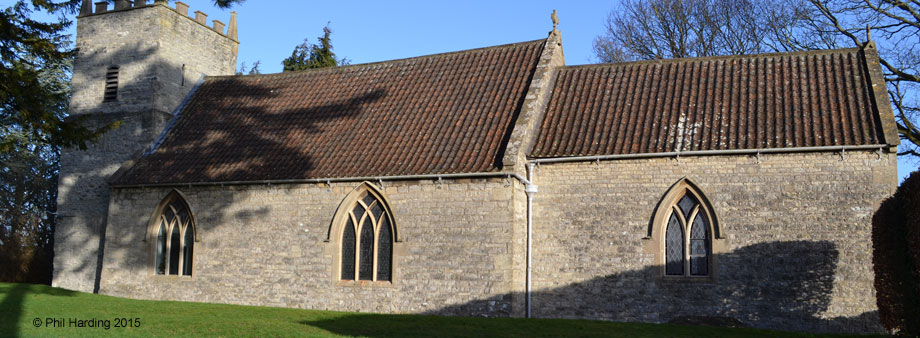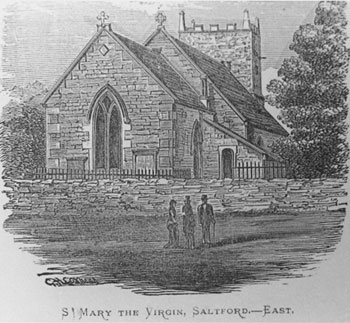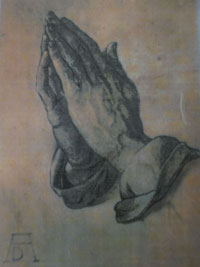|
SEG Home > History of Saltford > A - Z > St Mary's
The History of Saltford
St Mary's Church
Queen Square
Saltford
Bristol BS31 3EL
www.stmaryssaltford.org.uk
The people of Saltford have worshipped God through his son Jesus Christ on this site for over a thousand years
St Mary's Church in Saltford was first constructed in early Norman times. However the base of the tower is thought to be late Anglo-Saxon period; the Anglo Saxons would almost certainly have recycled cut stone from Roman buildings in the locality to build the tower. The building has been altered and extended many times since then.
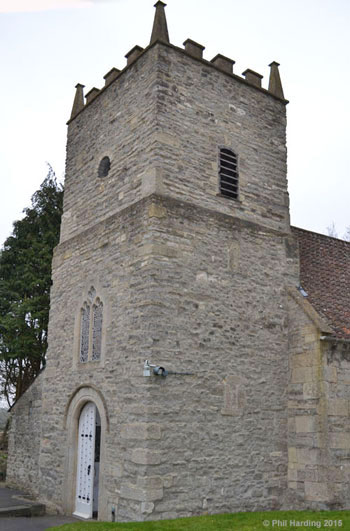
Tower - base is possibly late Anglo-Saxon period (pre-Norman conquest)
(Photo. 2015)
Up until around the mid-16th Century the Porch in a church building such as St Mary's was used mainly for the witnessing of weddings, baptisms, funerals and childbirth thanksgivings (known as "Churchings"). The main "church" (now called the Nave) was used for village events that were religious or secular (plays, village dances, markets, ale feasts etc.), just like a modern day village hall. Daily masses and offices were sung in the quire and at altars, east of the rood screen. It is unknown when St Mary's rood screen was removed.
Saltford Manor House is located directly adjacent to St Mary's Church. The manor house's 13th Century chapel (which collapsed and was not replaced in the 20th Century), the Norman window and the religious 13th Century wall paintings strongly suggest ecclesiastical origins for the house and that it was probably the original home (rectory) for the parish priest.
Saltford (as 'Salford') appears in returns from commissioners for the Valor Ecclesiastus* (the value of the Church) that commenced in 1534 on the orders of Henry VIII. Saltford (entered as 'Salford') was recorded in the Valor Ecclesiastus as a parish with an independent Rectory, the rector being Thomas Horsyngton with a total cash income of £10 9s 10d from which he
already paid dues to the Bishop of Bath of 4s a year and would pay tax to Henry VIII from 1535 of 20s (£1) and 7d. The Valor Ecclesiastus entry for Keynsham Abbey has no mention of Saltford/Salford, confirming the financial independence of the parish of Saltford.
*Explanatory note: Valor Ecclesiastus records the income of all clergymen, parish priests, monasteries, colleges, hospitals and other institutions under church auspices in order to tax them at ten per cent of their income after deductions for expenses. Valor Ecclesiastus provides an invaluable understanding of the scale of the wealth of the church on the eve of far-reaching Reformation changes, though the clergy continued to pay the monarchy tax at this rate until 1664, when some changes were made.
The King James lectern bible (2nd Edition, 1612) at St Mary's was in use on the lectern until modern times and has been rebound and restored. It is now retained at Wells Cathedral Library for safe keeping.
The Civil War & St Mary's (1643)
It is said that after the Battle of Lansdowne (on the outskirts of Bath) in 1643, a party of Roundheads pursued a group of Royalists across the ford in Saltford, but lost them in the woods around Stantonbury Hill. Stantonbury Hill is to the south of Saltford and is the site of an Iron Age hillfort near Stanton Prior, Marksbury.
On returning and finding that they were unable to re-cross the ford, as the tide had risen, they vented their anger on St Mary's church.
They found some fine stained glass in the chancel window and in the south windows of the nave. This they completely smashed, defaced and removed the font, and even ripped up some of the paving stones. The damage to the chancel was so extensive that restoration was impossible at the time. The chancel arch was walled up and the nave only used for a while. The Rector at the time was taken away by the Roundheads and not seen again.
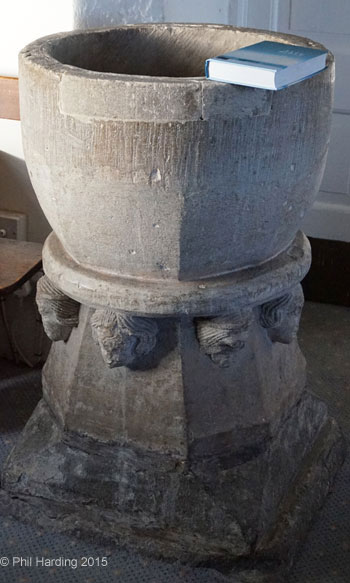
(Photograph 4.3.2015)
The unique font, with eight angel heads, is Norman or perhaps even Anglo-Saxon. As described above it was removed by Roundhead soldiers during the civil war and used as a cattle trough. The font was eventually returned to the church and mounted on a new base.
The Tower
The originally low part of the tower is thought to be Anglo-Saxon in part, but has been extensively altered and repaired since. A further 10ft was added and the stone pinnacles were built in Victorian times.
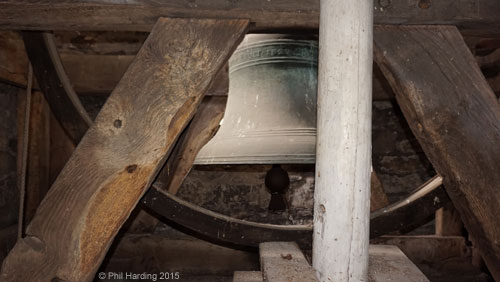
The tower once housed three bells; the one remaining bell was made in London (Whitechapel Bell Foundry) in 1820 and is pictured above.
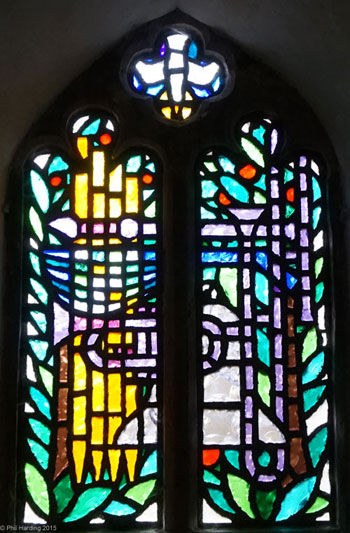
A recent addition to the tower is the modern window directly above the door. It is a good example of modern stained glass, showing various musical instruments. It was installed in 1975 and was in memory of Cecil Ewins, a former church organist and choirmaster. The November 1975 Parish Magazine (see below) includes an article about this wondeful window.
The gallery was erected during the major church restoration of 1832, and the west window extended upwards to provide it with more light. The embroidered Coat of Arms on the front of the gallery dates from soon after the Battle of Waterloo. This intricate stitch had a very brief popularity, which gives it its precise date.
The Flower Family Memorial (1639)
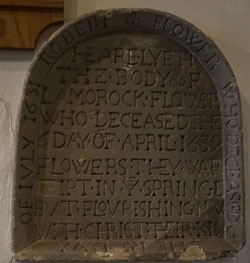
Near to the piano at the top of the Nave you can find a round-headed tablet, a memorial to 17th Century members of the Flower family.
The Flower family lived next door in Saltford Manor House (known then as Manor Farmhouse, Saltford) for many generations, from about 1645. Saltford Manor House is largely a Norman building, which in medieval times may have belonged to Keynsham Abbey, is reputedly the oldest occupied manor house in the country.
The centre of the memorial reads:
"Heare lyeth the body of Lamorock Flower, who deceased the 6 day of April 1639. Flowers they warshipt in ye Springe but flourishing now with Christ their King". But around the margin of the tablet, commencing at the left hand corner, is engraved "Robert Flower, who deceased the first day of July, 1631".
All went well with this lettering until the bottom edge was reached, when complications arose for the sculptor. Realising that the wording must read from right to left, instead of the usual way, he quaintly spelt the words backwards. On the west wall of the nave as well as in the churchyard, there are further memorials to the Flower family, who stayed in the village until late Victorian times and who all had the unusual first name of Lamorock.
Frances Flood (1723)
A particularly interesting memorial in the Church is not to a person, but to a woman's feet(!). In 1723, Frances Flood was passing through Saltford when she became infected with the Smallpox. As she knew no-one in the village, and was denied lodging by the Overseer (village leader), she stayed in a barn.
Over the following months her condition worsened until eventually her feet and lower legs dropped off, due to gangrene. Miraculously, her legs healed within two hours, without help from a Physician or Surgeon. The memorial she left in the Church reads thus as follows:
Stop Reader, and a Wonder see
As strange as e'er was known,
My Feet drop'd off from my Body
In the Middle of the Bone:
I had no Surgeon for my Help,
But God Almighty's Aid,
In whom I ever will rely.
And never be afraid.
Tho' here beneath they lie
Corruption for to see;
Yet they shall one Day re-unite
To all Eternity.
St Mary's in 1789
Here we show two pictures of St Mary's drawn in 1789. You can see the porch on the south side of the church, which was demolished in an extensive renovation in 1832. The materials were used to build the vestry on the north side of the church, and
the main entrance to the church was moved to the bottom of the tower, at the west end.
(i)
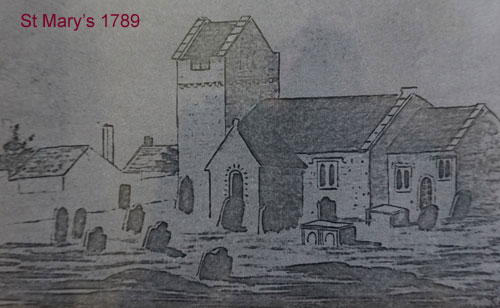
The above simple artistic impression of St Mary's in 1789 hangs in the church and shows the entrance on the south of the Nave before it was moved to the bottom of the tower, at the west end in 1832. A better and more detailed 1789 picture of St Mary's that also shows Saltford Manor House can be seen below.
(ii)
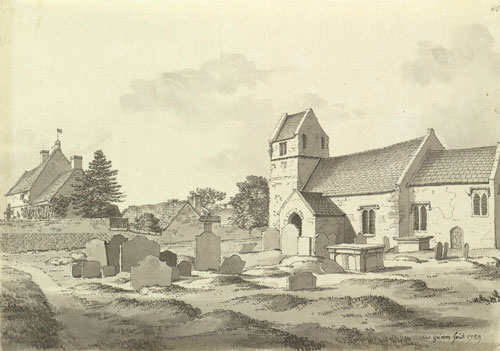
This picture also drawn in 1789 (ink wash on paper, courtesy of the British Library) is by Samuel Hieronymus Grimm, the famous Swiss illustrator who specialised in documenting historical scenes and events. You can view a larger version in our Online Museum >>.
St Mary's in 1791
The description below of St Mary's is an extract from the entry for Saltford in the 'History of the Antiquities of Somerset' by John Collinson (1791). The full text can be found in our Online Museum (go to 18th C section).
Note: We have reproduced the punctuation and spelling of words as used in the original article but replaced the use of the character f with "s" as appropriate.
The church, valued in 1292 at six marks and a half,b is rectorial in the deanery of Redcliff and Bedminster, and in the patronage of the Duke of Chandos; the Rev. Mr. Davies is the present incumbent.
The church is a small structure, dedicated to St. Mary, having one aile, with a clumsy tower at the west end containing one bell.
On the left hand side of the communion-table, is a monument of white veined marble, inscribed, - "To the memory of the Rev. Haviland John Hiley, who was rector of this parish 42 years; and also to the memory of Eleanor his wife, and exact in performing their duty to GOD, their neighbour, and themselves. He died Sept. 27, 1754, aged 65 years; she Feb 13, 1770, aged 82."
There are also divers[e] memorials to the families of Richmond, Purnell, Flower, Hunt and Browning.
b Taxat, Spiritual.
~
Acknowledgements/Information Sources
"History of the Antiquities of Somerset" by John Collinson (1791).
"St Mary's Saltford - A Brief History" by Sam Norris, July 2007.
www.stmaryssaltford.org.uk (2015).
Martin Renshaw (re. Valor Ecclesiastus & historical information concerning the use of church buildings in the medieval and post-medieval period), 2017.
Return to top of page
The Rectors of Saltford (since 1321)
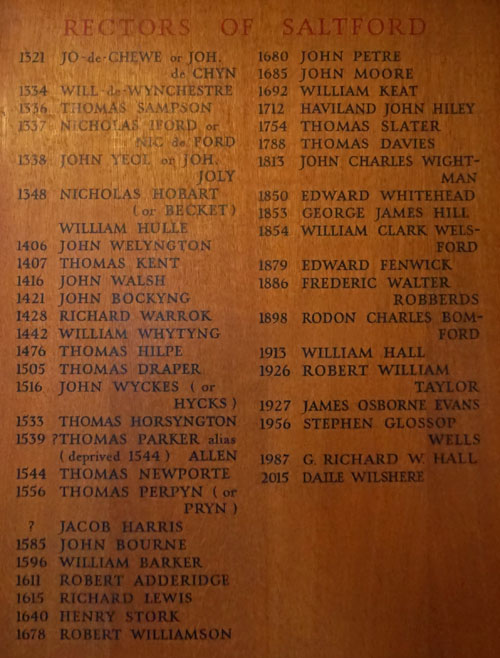
The list of Rectors of Saltford from 1321 to 2015
(displayed in the church)
What is important in your life?
The kind of things you have
or the kind of person you are?
How much you can get
or how much you can give?
Rev Richard Hall, Rector at St Mary's (1988 - 2014)
Poverty stricken Welsh clergyman appointed at Saltford, 1788
The appointment in 1788 of a new Rector for Saltford, the poverty stricken Rev Davies from Wales, by the British peer and Whig politician, the 3rd Duke of Chandos*, James Brydges (1731-1789), is recorded in the 21st March 1788 edition of the Bath Chronicle.
*Note: We are aware that the "manor of Saltford in the honour of Gloucester" having being passed between different owners became at around the later part of the sixteenth century the property of the Duke or Baron of Chandos. This was an earlier, possibly the 4th (1552-1602) or 5th (1581-1621) Baron
Chandos (from the second creation in 1554 of the Barons Chandos) and this tells us why it was, it would seem, in the gift of the subsequent 3rd Duke of Chandos to appoint the Rector at Saltford.
Rev Thomas Davies having accepted his appointment by the Duke of Chandos was Rector at Saltford for 25 years (1788-1813).
The Duke of Chandos** died in 1789, the year following his appointment of Rev Davies. He died on 29 September at age 57 in Tunbridge Wells, Kent from injuries received when his second wife, Anne Eliza Gamon, inadvertently moved the chair he was about to sit on... He was buried at Whitchurch, London.
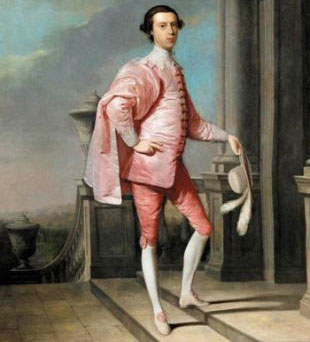
3rd Duke of Chandos, James Brydges (1731-1789)
The Duke was the last Duke of Chandos as he died without a male heir although his son-in-law, the 2nd Marquess of Buckingham, was made Duke of Buckingham and Chandos in 1822.
**Note: 2016 information source for 3rd Duke of Chandos: http://www.thepeerage.com/p1252.htm
We have reproduced here using the old spellings and punctuation of the original text from the article published in the 21st March 1788 edition of the Bath Chronicle. It gives an interesting insight into the poverty experienced then by Welsh (then spelt Welch) clergy, perhaps resulting from the low and unreliable tithe incomes in Wales, and thus explains why Rev Davies was assisted by the Duke of Chandos and appointed by the Duke to Saltford.
BATH CHRONICLE, 21st March 1788
Wednesday Richard Gamon, esq; member for Winchester, acquainted the Committee of the House of Commons, (appointed to consider the Returns of Charitable Donations,) that his Grace the Duke of Chandos hath most generously, with his wanted goodness of heart, presented the Rev. Mr. Davies, the poor Welch clergyman, whose affecting circumstances were stated in our paper of the 6th instant, with a rectory in Somersetshire, worth 120l. [£120] per annum.
His Grace, on the first hearing of the above clergyman's distressed case, sent him a bank-note of 20l. [£20] with a promise of his future patronage, which he has now so nobly fulfilled. - We hear the rectory is that of Saltford between this city and Bristol.
The distresses of the Welch clergy having lately attracted the public attention, and occupied a part of this paper, the following quotation from "Matthew's Tour of Observation and Sentiment through South-Wales," will enable the public to form some just conceptions of those neglected pastors; at the same time that it bespeaks the liberality, goodness, and discernment of a Quaker, whose works have received public applause.
THE WELCH CURATE
WHILE we are on the subject of inventories, I will subjoin one of the whole worldly goods of a Welch Curate, into whose apartment I happened accidentally to be introduced in his absence - and this I will do not to gratify a satirical disposition, for I trust I am superior to that, where poverty, and the wretchedness of an educated character are so obviously in the case.
In a gloomy chamber, I found the following store, most of which, to the credit of the owner (whose curacy I was informed was under ten pounds a year) will be found a provision for the mind rather than the body.
BOOKS.
Dyche's Dictionary, Salmon's Geographical Grammar, Sermons by R. Moss, Downame's duodecimo Concordance, and dragged duodecimo Bible, Sermons by Geo. Whitfield without a cover, a Common-Prayer Book, Watt's Hymns, Whole Duty of [-?-]lan, very old, first edition, Welch Catechism, Arithmetical Calculations, Le Clerk of the Christian Religion, Grotius of the truth of the same, the Thirty-nine Articles of the Church, a Greek
Testament, Wesley's Primitive Physick, Wake's Principles of the Christian Religion, a New Testament, a Latin Catechism, two old sermons cases, thirty-six printed and sixteen MS. Sermons, Advice to young Clergy, and the solitary Band of the order folded in it.
GOODS.
One ragged blue bed, three broken chairs, three old empty chests, one old table, one pair of breeches, one rusty church-going hat.
The forgoing library, scanty as it may be deemed for one of our priests in orders, was considered in Wales as neither small nor uncostly for a curate. Indeed when I afterwards cast my eyes on the dejected countenance of the poor man, to whom these few books belonged, I could not repress the rising of indignation, at the inequality of allowance among the clergy, so long, and so justly complained of, without redress.
Against such fruitless feelings, however, a traveller through Wales must guard himself as well as he can - and must remember, in aid of himself, and the miserable people whom he compassionates, that a period will soon come, when the luxury and wantonness of many rapacious dignitaries will be humbled, and recompensed; while the crying miseries of their more virtuous dependents will be ended and balanced, according to the mercy of Him who judgeth righteously in the earth.
[END]
Return to top of page
George III Coat of Arms tapestry (c.1815)
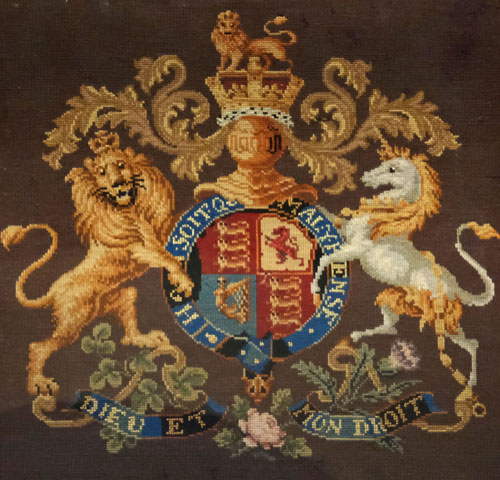
© Phil Harding 2021
This tapestry of King Charles III's Coat of Arms in St Mary's church is dated to c.1815, soon after the Battle of Waterloo. The date is determined by its intricate stitch from a brief period of popularity.
Return to top of page
St Mary's in 1876
1. The Church Rambler: St Mary's in 1876
"The Church Rambler" was a series of detailed articles on the churches in the neighbourhood of Bath written for the Bath Herald by Harold Lewis and published in 1876. We have transcribed Harold Lewis's article on St Mary's which gives a rare glimpse of Saltford in the 1870s and what went on at St Mary's.
For example "the heating apparatus was foul, and that now and again a volume of smoke escaped from the floor of the chancel some distance from the stove".
During the service attended by Harold Lewis, the sole occupants of the chancel "with the exception of a few little girls were a parish clerk and a man who attended the stove."
To the obvious distaste of Harold Lewis the Parish Clerk "paced the church before the service began, and repeated the responses in a much louder tone than the minister spoke, and with an intonation which the congregation could not imitate, were all equally unpleasant. In the demeanour of both himself and his companion there was a sense of self-importance, the natural result of their position". This the author found "unseemly" and "objectionable."
You can download this interesting account here (pdf, opens in new window):
2. Wedding at St Mary's, April 1876
Bristol Mercury 22nd April 1876:-
SALTFORD. A neat and pretty wedding took place in the parish church here on Monday last, and occasioned quite a stir in the quiet village. Miss Georginna Phippen Holbrook, a second daughter of Mr. W.F. Holbrook (late of Newton St. Loe), was married to Mr. Ezra Garrett, of Frome, the ceremony being performed by the rector, the Rev. W.C. Welsford. M.A. A beautiful bridal bouquet was very kindly given by Mrs. Kelly, and a
gentleman from Bath voluntarily played the "Wedding March." The church was full of spectators, and as the party passed through the churchyard numbers of persons were waiting on either side, wishing all happiness, and throwing rice, strewing flowers, &c. The bride wore a gray silk, and the bridesmaids white trimmed with blue.
Return to top of page
1880: Full military honours for Major Francis Haviland at St Mary's
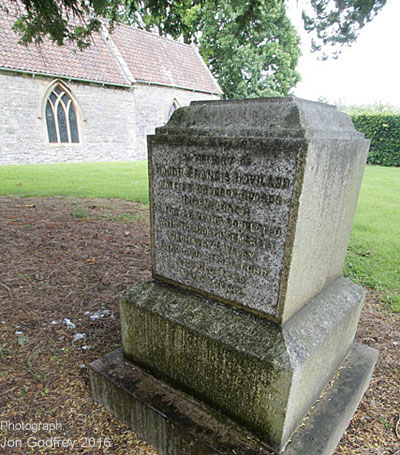
The major's memorial (in 2016)
Captain Francis Haviland (born in Romford Barracks, 1796) moved with his wife Mary (née Nagle, born in Eire in 1799, descended from the ancient Barons of Navan and the Noble House of Desmond) to Saltford Villa (subsequently renamed Tunnel House) in 1862. Mary died at The Villa in 1870 and Francis died there 10 years later in 1880, aged 83 years. There are no records of any children.
Major Haviland's funeral at St Mary's was reported in the Bristol Mercury (30th December 1880). The following are extracts from the report:-
FUNERAL OF MAJOR HAVILAND AT SALTFORD
The funeral of this gallant officer, whose name was honoured in the British army alike by the Commander-in-Chief and the private soldier, took place yesterday, at Saltford.
The deceased was born in Romford Barracks, in October, 1796... he entered the army as a private soldier at the age of sixteen... worked his way through all the subordinate ranks in the 2nd Dragoon Guards, till in 1852 he gained a captaincy, and for six years was Captain and Adjutant in the North Somerset Yeomanry Cavalry, which he left in hope of seeing active service with the Queen's Bays in India, but being disappointed in this, he took captaincy of the Queen Charlton troop of Yeomanry.
After being in 1867 gazetted captain in the 2nd West India Regiment, and retiring on full pay with the rank of major, he was appointed major in the North Somerset Yeomanry, with which force his name has been long and honourably associated... resigned his commission... within a month of his 84th birthday, after receiving injuries through being thrown from a restive horse while on duty with his regiment.
His chivalrous disposition and genial buoyancy of spirit had endeared him to all who knew him... When in "The Bays", he was popularly styled "The Father of the Regiment"... popularity with the North Somerset Yeomanry, and particularly with the members of the Queen Charlton troop... Year after year the troop, on their way to their eight days' permanent drill at Bath, never passed "The Villa" at Saltford without being hospitably entertained at luncheon.
...of him it might be said that, to the extent of the means at his command, his ever open door Obliged the wealthy, and relieved the poor.
...the burial service was read yesterday afternoon, the internment being in the small churchyard adjoining. Despite the continued rainfall, there were between three and four hundred persons present... the deceased was buried with full military honours. The noble lord was unable to be present, but a letter was read from him...
The Queen Charlton troop assembled almost to a man, there being 35 troopers present, besides the officers - Captain Ford, Lieut. Ford, with Quartermaster Gullifer, Sergt.-Major Kelly, and Sergt.-Major Booth, Quarter-master Pinkett, Quarter-master-Sergt. Virgin, and several troopers; and the Ston Easton troop by Captain Hippisley, Lieut. Kemble, Sergt.-Major Sinton...
...they paraded, under Captain Tricks and Lieut. Ward, at the Saltford Railway station, and marched down to the village at one o'clock...
The Yeomanry, in full dress, with helmets and plumes, and the Rifle Volunteers, having opened ranks and lined the roadway, the funeral procession was formed between one and two o'clock. First came the Rev. W. C. Welsford, late rector of Saltford, followed by the firing party, carrying their arms reversed, and consisting of the first half-company of the Rifle Volunteers, 25 rank and file, under command of Captain Tricks. Then came the battalion band, playing the Dead March in "Saul".
The coffin, covered with a deep pall of black velvet, edged with bullions fringe, had placed upon it deceased's helmet and sword, and a chaplet of white flowers and delicate ferns... The roadway was crowded with spectators as the procession made its way to the church the sad, wailing strains of the Dead March, played with marked expression by the band, producing a deep impression upon all present.
In the church grounds the firing party opened ranks for the bearers with the coffin and the mourners to pass into the church. Scarcely had the saddening strains died away before they were taken up by the organist within the church, and continued while the coffin was being placed in the centre of the nave, and the mourners gathered round. The church was elaborately dressed with wreaths of greenery for the Christmas festival, and some of the bright designs contrasted strangely with the funereal scene.
The service in church was conducted by the Rev. E. W. Fenwick, the rector, who read the opening sentences, and the Rev [ ]. J. Scott, the curate, who read the remainder. The Rev. J. H. Gray, vicar of Keynsham, was also present...
When the procession was leaving the church the organist, Mr. Uriah Moore, again played the Dead March very effectively. The service was continued to the grave, into the "silent calm" of which were deposited the remains of one whom all present had known only to love and esteem... the procession, re-forming, left the churchyard, the band playing the well-known... "Onward, Christian Soldiers."
...He has been constantly doing duty as a soldier of more than sixty-eight years, and has been repeatedly thanked by the Horse Guards and the general officers with whom he served for the zeal he displayed in the faithful and able manner he performed his duty... his Royal Highness Field-Marshall the Duke of Cambridge, in writing to the Earl of Cork, said he wished to do something for that good old soldier, Major Haviland.
Return to top of page
Music at St Mary's in the 1890s
When the long serving organist at St Mary's, Mr Uriah Moore, retired in 1890 having held the post for 38 years, he was presented with a "handsome timepiece in solid marble and an easy chair in leather". The presentation was made by the ex-churchwarden Mr Brimble and Mr Adams on Christmas Day at the residence of Mr Adams. The clock was supplied by Stier and Son of Bath and the armchair by Messrs Head of Bath.
A vestry meeting was held in the parish school room shortly before Christmas to seek the consent of the parishioners to sell the parish organ and to purchase a harmonium in its place. However, as the notice of the meeting by the church wardens had been informal nothing could be done. The organ was "closed" and a small harmonium used in its place.
According to the Bristol Mercury (1.1.1891) the parish church "intended to have an improved musical service, with a surpliced choir."
Acknowledgements/Information Sources
Bristol Mercury, 1 January 1891
Return to top of page
St Mary's and Saltford Manor House in the 1950s
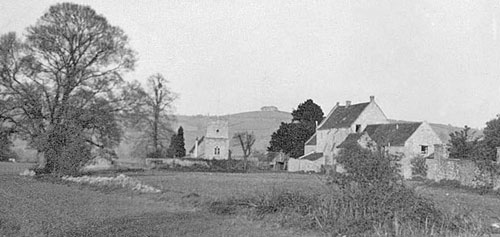
This photograph from the 1950s captures the rural setting of St Mary's next to Saltford Manor House. Kelston Roundhill (also known as Kelston Tump) can be seen on the horizon.
Return to top of page
St Mary's Parish Magazine, November 1975
To see the November 1975 edition of St Mary's Parish magazine click on the image below.
An article about the memorial window to the late Cecil Ewins in the tower above the porch can be found on page 9. It was commissioned by Mrs V Ewins, his widow, to commemorate the 10 years her late husband was organist and choirmaster at the church. Cecil Ewins held many community roles in Saltford, including leading the Scouts; this new window in 1975 was a fitting tribute.
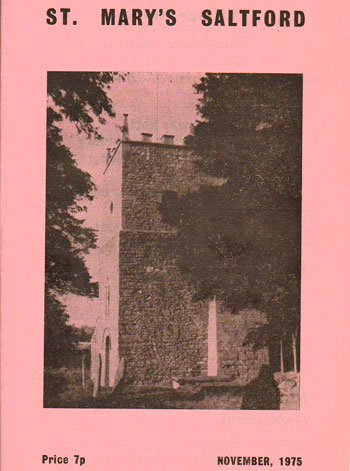
Click on image to open magazine in new window (pdf 3.9Mb).
On page 2 you can find St Mary's in pictures >>

© Saltford Environment Group
W3C compliant website. Web page designed and produced by Phil Harding.
|
